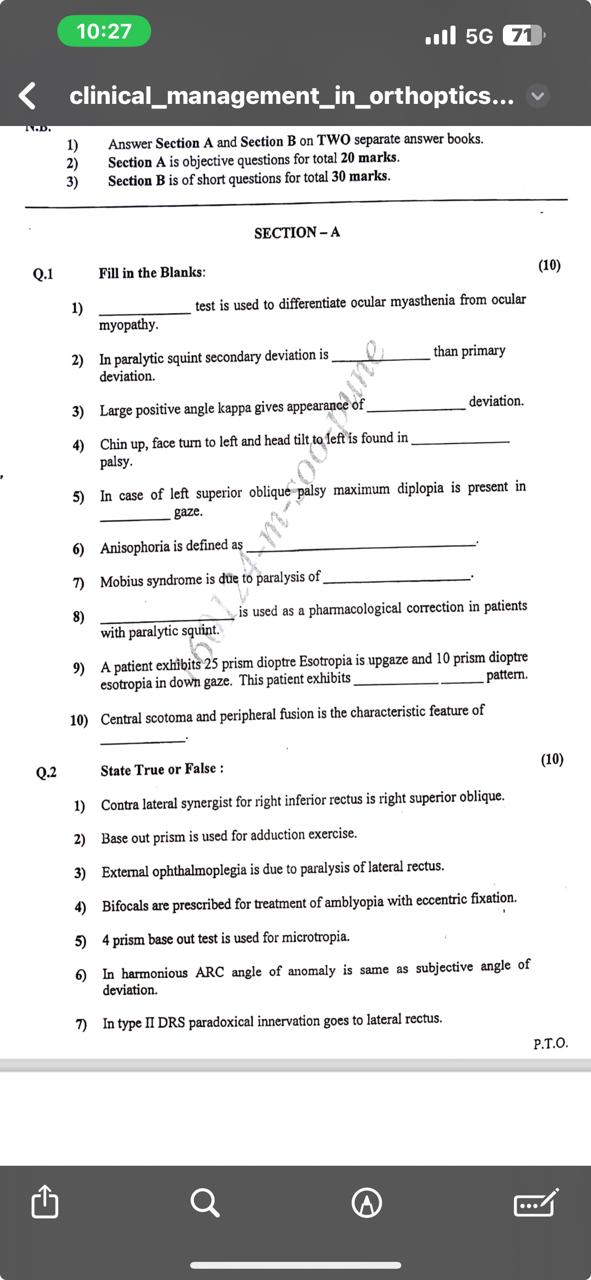1) ________ test is used to differentiate ocular myasthenia from ocular myopathy. 2) In paralytic squint secondary deviation is ________ than primary deviation. 3) Large positive a... 1) ________ test is used to differentiate ocular myasthenia from ocular myopathy. 2) In paralytic squint secondary deviation is ________ than primary deviation. 3) Large positive angle kappa gives appearance of ________ deviation. 4) Chin up, face turn to left and head tilt to left is found in ________ palsy. 5) In case of left superior oblique palsy maximum diplopia is present in ________ gaze. 6) Anisophoria is defined as ______________________. 7) Mobius syndrome is due to paralysis of ______________________. 8) __________ is used as a pharmacological correction in patients with paralytic squint. 9) A patient exhibits 25 prism dioptre Esotropia is upgaze and 10 prism dioptre esotropia in downgaze. This patient exhibits ____________________ pattern. 10) Central scotoma and peripheral fusion is the characteristic feature of __________. 11) Contra lateral synergist for right inferior rectus is right superior oblique. 12) Base out prism is used for adduction exercise. 13) External ophthalmoplegia is due to paralysis of lateral rectus. 14) Bifocals are prescribed for treatment of amblyopia with eccentric fixation. 15) 4 prism base out test is used for microtropia. 16) In harmonious ARC angle of anomaly is same as subjective angle of deviation. 17) In type II DRS paradoxical innervation goes to lateral rectus.

Understand the Problem
The question is requesting answers to a series of fill-in-the-blank statements and true or false statements related to clinical management in orthoptics. It tests knowledge on specific terms, conditions, and practices in the field of ophthalmology.
Answer
1) Ice pack test. 2) Larger. 3) Exotropia. 4) Fourth nerve. 5) Downward. 6) Variable phoria. 7) Sixth and seventh cranial nerves. 8) Botulinum toxin. 9) A pattern. 10) Amblyopia.
- Ice pack test. 2) Larger. 3) Exotropia. 4) Fourth nerve. 5) Downward. 6) Variable phoria depending on gaze direction. 7) Sixth and seventh cranial nerves. 8) Botulinum toxin. 9) A. 10) Amblyopia.
Answer for screen readers
- Ice pack test. 2) Larger. 3) Exotropia. 4) Fourth nerve. 5) Downward. 6) Variable phoria depending on gaze direction. 7) Sixth and seventh cranial nerves. 8) Botulinum toxin. 9) A. 10) Amblyopia.
More Information
The ice pack test is a reliable diagnostic tool for ocular myasthenia gravis as it temporarily improves ptosis. Secondary deviation in paralytic squint is typically larger than primary deviation, and a large positive angle kappa can simulate exotropia. Fourth nerve palsy affects eye movements, causing characteristic head positioning.
Tips
Ensure to differentiate between various types of phoria and tropia in questions related to ocular motility.
Sources
- Case report: Importance of clinical tests in ocular myasthenia - PMC - ncbi.nlm.nih.gov
- Wright's Strabismus Review Crazy Easy - wrighteyecare.com
- Ocular Myasthenia Gravis - Brigham and Women's Hospital - brighamandwomens.org
AI-generated content may contain errors. Please verify critical information